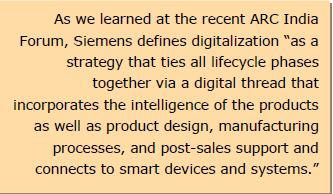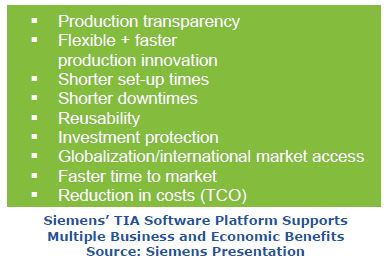

Summary 
Analytics: The First Step to Industrie 4.0
Siemens, a major supplier of industrial automation solutions, recently briefed ARC analysts on the company's new analytics platform called MindSphere. Key takeaways from the briefing include:
The "digital transformation" has been under way for years in other areas, but is just now reaching the industrial world. The media, retail commerce, banking, and many other sectors have already taken advantage of new business opportunities afforded by the digitalization of their assets, products, and business processes. However, industrial applications are much more complex. There is quite a difference between implementing eight sensors in a smart phone versus thousands of data points in an industrial plant. Also, investment cycles in the manufacturing and process industries are much longer and companies are slower to adopt new technologies – hence the late start for the digitalization of industry.
But now, some industrial suppliers have caught up with the IT world and begun offering platforms for analytics with tools geared to the specific needs of industrial users. Currently, Siemens, IBM, PTC, and General Electric (among others) offer analytics solutions targeted at industrial users.
In 2015, Siemens introduced MindSphere, its cloud-based platform for analytics. MindSphere is an open ecosystem that provides tools and services for users to develop their own analytics applications, or offer analytics as a digital service to their customers. These services include data recording, transmission, and safe storage, as well as a framework for developing applications quickly. Rather than offering a complete ecosystem by itself, Siemens has entered into a number of partnerships to support the platform. The open architecture is based on SAP HANA. Siemens soon plans to expand the number of hosting partners to include Atos and Amazon Web Services, as well as a Chinese-based provider, according to the company.
Analytics for Everyone
The analysis of Big Data in industrial applications used to be reserved for data scientists working for big companies with large budgets. The focus was usually on product quality, meaning that data were gathered from samples and inline analysis and, less often, data about the condition of equipment. While analytical tools from the IT world could be applied, it was often difficult or impractical to access data from automation systems, and especially from remote locations. Often, the problem was people. Machine builders and end users traditionally haven't employed staffs with the right combination of data analysis skills and process knowledge.
Automation systems have always produced large amounts of data, but these were mostly left "to rot on the vine" because of the difficulty to harvest them. Traditional automation architectures did not keep pace with open information technologies, so gathering data was cumbersome and often not possible down to the sensor/actuator level. But times are changing quickly. Ethernet is now the norm in automation architectures, and the "last mile" to edge devices is being paved with new IP-based solutions like APL for explosive environments, or IO-Link for low-cost sensors in applications where an IP connection may be too expensive.
The Urge to Analyze
Industrial companies invest huge sums in process and production equipment with lifecycles often measured in decades. And yet 
Analytics in industrial applications can produce surprisingly quick returns on investment by avoiding or even predicting equipment failures before they happen. The value of this capability cannot be underestimated. Losses due to unforeseen production stops range from lost production time to whole batches that have to be thrown away. Even small manufacturing companies can improve their productivity greatly by eliminating unscheduled downtime. Machine builders can employ analytics to create whole new business models based on remote digital services that generate new after-sales revenue streams and maintain relationships to distant customers. Moreover, analytics can be applied on top of existing processes and don't need to be designed in from the beginning.
New analytics solutions like MindSphere help users with process knowledge, but not necessarily data analysis skills, to quickly set up an analysis. The beauty of such solutions is that they are infinitely scalable. While complex analyses of large data sets or streaming data are possible, MindSphere also allows users to get up and run quickly by configuring simple analyses that can be optimized or expanded later.
A solution for industrial analytics is made up of more than just tools to search existing data. Analytics requires an infrastructure that understands the protocols of existing architectures. Data first need to be extracted from legacy equipment, often located at remote sites, before they can be filtered and put into perspective.
Conclusion
Inspired by Industrie 4.0 and IIoT, many industrial companies already have formal digitalization initiatives in place. With the advent of industrial analytics platforms, like Siemens' MindSphere, companies can now optimize their manufacturing processes by harvesting and analyzing data in ways that were previously impossible or impractical. Users can also leverage their installed base to create new digital services. For companies that are currently behind the digitalization curve, analytics is a great first step to explore the many ways in which digitalization can transform industrial companies.
ARC Advisory Group clients can view the complete report at ARC Client Portal on www.ARCweb.com or Box.com
If you would like to buy this report or obtain information about how to become a client, please Request ARC Info
Keywords: Analytics, Siemens, MindSphere, Data Scientist, Unscheduled Downtime, ARC Advisory Group.

